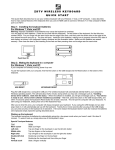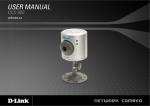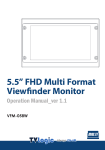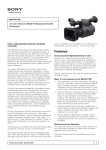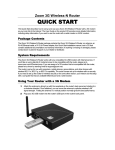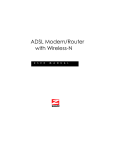Download Zoom ZDTV Wireless Keyboard 9006
Transcript
ZDTV WIRELESS KEYBOARD QUICK START This Quick Start describes how to use your wireless keyboard with any Xbox 360 or PS3 gamebox; or with a Windows 7, Vista, or XP PC. It also describes how to enjoy special features of the keyboard when connect a Windows 7, Vista, or XP computer to an HDTV. Quick Setup for all users (Complete setup for Xbox 360 and PS3 gamebox users) Step 1: Installing the keyboard batteries and powering ON the keyboard 1 On the bottom of the keyboard, push the arrow on the edge of the door away from the keyboard. The door will open. Install two AAA batteries, making sure to position the Plus side of each battery as shown in the keyboard’s battery container and the illustration below. Make sure the batteries are seated securely. Now close the door by first inserting it and then pressing it toward the keyboard. Back of keyboard 2 Battery case To power ON the keyboard, turn the power switch located on the back of the keyboard from OFF to ON. Step 2: Mating the keyboard to a gamebox or computer and using the keyboard If your computer or other device isn’t already running, power it up now. To pair the keyboard with your gaming device or computer, plug the USB dongle into an available USB port. USB dongle Note for Windows PCs: The wireless keyboard will automatically identify itself to your PC’s Windows operating system or other device. You may see a message such as, “Found New Hardware.” To start using your keyboard, simply press one of the keyboard’s keys. If you unplug the USB dongle and you later plug it back in, it will automatically pair up with the keyboard. If for some reason the keyboard doesn’t work (for instance, the batteries were replaced) simply repeat the pairing described above. Waking up the keyboard The keyboard conserves its batteries by automatically going into a low-power mode when you haven’t used it for about 5 minutes. To wake it back up, simply press one of the keyboard’s keys. Keyboard features LEDs When lit, the LEDs on the top right of your ZDTV keyboard indicate the following: 1 Number lock A Caps lock Low Batteries Touchpad and left and right buttons An integrated touchpad and left and right touchpad buttons are on the right-side of the ZDTV keyboard. These are used with Windows computers, not gameboxes. Mute audio Congratulations! If you are using an Xbox 360 or PS3, the keyboard is ready to use. Continued Setup for Windows PC users If you are already connected to an HDTV and are satisfied with the screen resolution, you are ready to use the ZDTV keyboard and do not need to proceed any further. Otherwise, proceed with Step 3 below. Special Touchpad features: Goal Move cursor Left click Middle click Right click Double left click Drag Vertical scroll Action Slide your finger Tap one finger on the touchpad or use the left-click button Tap two fingers on the touchpad Tap 3 fingers on the touchpad or use the right-click button Double tap one finger on the touchpad Double tap the touchpad and then slide your finger Slide 2 fingers vertically Step 3: Connecting an HDTV to your computer For Windows 7 If you have a Windows 7 computer with an HDMI port, we highly recommend that you try using the computer with an HDTV and the wireless keyboard. This is particularly convenient with a notebook or small desktop computer. We want you to be able to enjoy all your computer has to offer, including the Internet, from your favorite chair. Special functions on the keyboard, including Magnify features, work with our software to make using it with an HDTV easy and fun. 1 Most HDTV sets have an HDMI port. If your HDTV does have an HDMI port, plug an HDMI cable into a free HDMI port on the HDTV. 2 Plug the other end of the cable into an HDMI port on your computer. If all your HDTV’s HDMI ports are used, ZDTV may have to share an HDMI input with a DVD player or other device. (If your Windows 7 computer does not have an HDMI port, you can try connecting to an HDTV using a VGA or DVI video connection. You may get acceptable performance, depending on the capabilities of your computer and HDTV, but some ZDTV features may not work correctly.) 3 Your HDTV remote or a button on your HDTV lets you select the TV’s input. Typically you press Source, Input, or a similarlynamed button on your remote or HDTV to select among your set-top box, DVD / BD player and other devices. Selecting your computer for the screen input is similar to selecting a DVD player. Select your computer as the HDTV input. Check to make sure that you see your computer’s Windows desktop on your HDTV. 4 You will see the message New Display Detected. Select Show my desktop on the external display only. Select Apply and then select OK. For Windows Vista Note: Windows Vista users with Desktop PCs should connect only the HDTV; no other monitor or display should be connected at the same time. 1 Your PC may offer a DVI connector. If it does, use a DVI to HDMI cable to connect your PC to your HDTV. Otherwise, in most cases, your PC will have a VGA port. Connect this port to a VGA input port on your HDTV. When using an HDMI to HDMI cable, you will see the message New Display Detected. Select Show my desktop on the external display only. Select Apply and then select OK. 2 3 Note: If you connect via DVI or VGA, you will separately need to make an audio connection. Your HDTV remote or a button on your HDTV lets you select the TV’s input. Typically you press Source, Input, or a similarlynamed button on your remote or HDTV to select among your set-top box, DVD / BD player and other devices. Selecting your computer for the screen input is similar to selecting a DVD player. Select your computer as the HDTV input. If you have connected via VGA, often this will be labeled “PC.” Check to make sure that you see your computer’s Windows desktop on your HDTV. Power up your computer if it isn’t already on. If you can’t see a display on your HDTV, or the picture doesn’t look ideal, go to Step 5: Optimizing Screen Settings when you connect your PC to your HDTV. Then come back to Step 4: Installing the ZDTV software. Otherwise, continue with Step 4: Installing the ZDTV software. For Windows XP Note: Windows XP users with Desktop PCs should connect only the HDTV; no other monitor or display should be connected at the same time. 1 In the vast majority of cases, your PC will have a VGA port. Connect this port to a VGA input port on your HDTV. Note: You will separately need to make an audio connection. 2 Your HDTV remote or a button on your HDTV lets you select the TV’s input. Typically you press Source, Input, or a similarlynamed button on your remote or HDTV to select among your set-top box, DVD / BD player and other devices. Selecting your computer for the screen input is similar to selecting a DVD player. Select your computer as the HDTV input. If you have connected via VGA, often this will be labeled “PC.” Check to make sure that you see your computer’s Windows desktop on your HDTV. 3 Power up your computer if it isn’t already on. If you can’t see a display on your HDTV, or the picture doesn’t look ideal, go to Step 5: Optimizing Screen Settings when you connect your PC to your HDTV. Then come back to Step 4: Installing the ZDTV software. Otherwise, continue with Step 4: Installing the ZDTV software. Step 4: Installing the ZDTV software if you have a CD ROM drive in your computer For Windows 7, Vista, and XP Make sure your computer is on and connected to the Internet, and that you are logged on to an account with administrative privileges. The CD that came with your keyboard should run automatically when inserted into your computer’s CD/DVD ROM drive. If it does not, go to the Start menuÆ All ProgramsÆ AccessoriesÆ Run and type E:Setup.exe where E: is the letter of your CD ROM drive. Follow the on-screen instructions to complete the software installation. If the keyboard times out during any phase of the installation process, press the Fn key to re-activate the keyboard. Note: If you get a message stating “This program might not have installed correctly" you should click on “This program installed correctly”. If you are prompted to enter a 4-character Activation Code during software installation, please enter ZDTV. If a dialog box appears to upgrade ZDTV, select Upgrade Now and click Continue. Activation Code: ZDTV Installing ZDTV software if you don't have a CD ROM drive in your computer You will need to download the ZDTV software from the Zoom website. Make sure your computer is connected to the Internet. Open a browser and type http://zdtv.zoomtel.com/download in your browser's address bar. Follow the on-screen instructions to download and install the software on your computer. If the keyboard times out during any phase of the installation process, press the Fn key to re-activate the keyboard. Step 5: Optimizing Screen Settings when you connect your PC to your HDTV For Windows 7 Double-click the ZDTV icon on your Windows desktop to launch the ZDTV software that was installed. The first time you do this, the Screen Setup Wizard will run. Answer the Wizard’s simple questions to set up your computer for your HDTV. If you are using a notebook, keep the lid open while you do this. The ZDTV wizard will turn off your notebook’s screen and adjust video settings for the best possible picture on your HDTV. You may close your laptop’s lid when instructed below. You may be asked to change your HDTV’s video setting for the HDTV input that connects to your computer. Depending on the model of your TV, you may find HDTV screen adjustment settings under one of these video menu titles: Aspect, Format, Picture Format, Screen, Picture Size, Size, Viewing Modes, View Mode. If you select one of the above, you will see another list of menu options which will typically include one or more of the following 1:1, 16/9, Aspect, Dot-by-Dot, Full Pixel, Just Scan, Native, Pixel-by-Pixel, and Screen Fit. Try any of these options that you see on your TV’s menu until you find the optimal setting. If you still have problems with the display - for example, only part of the items located at the edge of the screen are visible, such as the Start button in Windows (or the circles in squares in the test screen) - try turning off an "overscan" setting. This may be called overscan, cropping, or something similar. An overscan or cropping setting is likely to appear in a menu close to the one that controls the screen settings we described above. If you are using a notebook and you disconnect the HDMI cable from your HDTV, your notebook’s screen will turn on whenever the notebook is On. Whenever you reconnect your HDTV to your notebook, your notebook will automatically adjust its video display to turn off the local display and generate the optimal display for your HDTV. You should not have to run the ZDTV Wizard again unless you use a different HDTV. If you connect a notebook to your HDTV, ZDTV software ensures that the notebook will not go to standby or shut down automatically even if the notebook’s lid is closed. This makes it easy to tuck the notebook into a convenient place. If you use a desktop computer, ZDTV will leave alone any power mode settings you may have set. If you connect your notebook to a different HDTV, the Screen Setup Wizard may run again. If you need to adjust the screen, click Help and then Adjust Screen. Please continue with Step 7: Using your notebook computer with an HDTV. For Windows Vista users with Notebooks or Desktops This process may require you to make adjustments to the display settings on your PC and to the Screen or Picture settings on your HDTV. When you are done you should have the highest resolution picture possible and it should fit neatly within your display. Note: Windows Vista users with Desktop PCs should connect only the HDTV; no other monitor or display should be connected at the same time. Click Start Æ (Settings) Æ Control Panel Æ Appearance and Personalization Æ Personalization Æ Display Settings. (in Category View) FOR DESKTOPS ONLY: Continue with Step 6: Adjusting Your Screen Settings. FOR NOTEBOOKS ONLY: From Display Settings select your HDTV from the drop-down menu. Select the checkbox “This is my main monitor”. Then select the notebook screen from the drop-down menu. Un-check the box “Extend the desktop onto this monitor”. Alternatively, depending on your notebook, you can press the Fn key and F2 or F4 or whichever key has an icon of a screen or the words CRT/LCD on it to make the HDTV the main display. Continue with Step 6: Adjusting Your Screen Settings. For Windows XP users with Notebooks or Desktops This process may require you to make adjustments to the display settings on your PC and to the Screen or Picture settings on your HDTV. When you are done you should have the highest resolution picture possible and it should fit neatly within your display. Note: Windows XP users with Desktop PCs should connect only the HDTV; no other monitor or display should be connected at the same time. FOR DESKTOPS ONLY: Click Start Æ (Settings) Æ Control Panel Æ Appearance and Themes Æ Display Æ Settings. (in Category View) FOR NOTEBOOKS ONLY: On your notebook’s keyboard, press the Fn key and F2 or F4 or whichever key has an icon of a screen or the words CRT/LCD on it to make the HDTV the main display. If you press the same set of keys a second time, both monitors will function. If you press the same set of keys a third time, only the notebook monitor will have a display. Continue with Step 6: Adjusting Your Screen Settings. Step 6: Adjusting Your Screen Settings For Windows Vista and XP Check your TV’s documentation to find its resolution. This will be either 720p or 1080i or 1080p. If your TV is a 720p device, set your PC’s screen resolution to one of the following widescreen resolutions: 1280x720, 1280x768, or 1360x768. If you don’t see one of these resolutions, your PC’s graphics card may not support widescreen resolutions. You can set the resolution to a standard 4:3 resolution, leaving black columns to either side of the display. The preferred resolution in this case is: 1024x768. If your TV is a 1080i or 1080p device, set your PC’s screen resolution to one of the following widescreen resolutions: 1920x1080, 1600x900, 1440x810, 1360x768, or 1280x720. If you don’t see one of these resolutions, your PC’s graphics card may not support widescreen resolutions. You can set the resolution to a standard 4:3 resolution, leaving black columns to either side of the display. Preferred resolutions in this case are: 1400x1050 or 1280x1024. 1 2 3 4 From the Display Settings (for Windows Vista users) or Settings (for Windows XP users) dialog, adjust the screen resolution slider to match your HDTV’s resolution. Look at the display on your HDTV. There are two kinds of problems that you may notice. The first is that the image may not fit well on the display. The second is that shapes and text may be stretched in one direction or another. If you notice one of these issues, follow these instructions to make adjustments: Depending on the model of your TV, you may find HDTV screen adjustment settings under one of these video menu titles: Aspect, Format, Picture Format, Screen, Picture Size, Size, Viewing Modes, View Mode. If you select one of the above, you will see another list of menu options which will typically include one or more of the following 1:1, 16/9, Aspect, Dot-by-Dot, Full Pixel, Just Scan, Native, Pixel-by-Pixel, and Screen Fit. Try any of these options that you see on your TV’s menu until you find the optimal setting. If you still have problems with the display - for example, only part of the items located at the edge of the screen are visible, such as the Start button in Windows (or the circles in squares in the test screen) - try turning off an "overscan" setting. This may be called overscan, cropping, or something similar. An overscan or cropping setting is likely to appear in a menu close to the one that controls the screen settings we described above. If it is impossible to rectify the image, try using a smaller resolution on the PC, and if necessary come back to the TV screen adjustments. Step 7: Using your notebook computer with an HDTV For Windows 7, Vista, and XP Here we assume: • You have already plugged an HDMI cable into your HDTV, so that one end is connected. The other end is open and waiting for your notebook to be plugged in. • Your notebook has ZDTV software installed and properly set for your HDTV. When you want to use ZDTV, plug the wireless keyboard’s USB dongle into an available USB port on your computer. (If possible, keep the dongle as far away from other wireless devices as possible.) Then plug the loose end of the HDMI cable into your computer. If your computer is a notebook and you close it now, ZDTV software knows not to shut down your notebook’s operation. Put the computer in a good place, where it won’t fall or overheat. Step 8: Using the keyboard with an HDTV For Windows 7, Vista, and XP ZDTV provides browser software that is designed to help you find and enjoy streaming media and other Internet sites for viewing on your HDTV. However, you do not need to use ZDTV browser software to enjoy the Internet or any of the features of your PC on your HDTV. You can still use the magnify features on Windows 7 and Vista by pushing the magnify buttons on the keyboard. To launch the ZDTV browser anytime after the one-time setup is completed, you can double-click the ZDTV icon on your Windows desktop. You can also launch the ZDTV browser by pressing the button on your ZDTV keyboard above the touchpad. To exit ZDTV browser software (anytime after the one-time setup is completed), you have 3 options. You can, 1. move your cursor over Help on the left side of the screen and click on Exit ZDTV, or 2. move your cursor to the extreme right edge of the screen below the ZDTV logo and let it hover for several seconds (or press F2) and move your cursor over Now Playing. Then click on Exit ZDTV, or 3. press F10 to exit. Now pick up the wireless keyboard, hit a key to make sure that it’s awake, sit in your favorite chair, and enjoy! You can use your wireless keyboard like any Windows keyboard. However, note the special buttons below on your wireless keyboard for launching ZDTV, magnification, and muting the audio. Launch ZDTV Magnify On/Off Magnification Level/Box size Mute audio ZDTV Magnify For Windows 7 and Vista The ZDTV wireless keyboard has special Magnify features so you can even see fine print from your favorite chair. The buttons for controlling these features are shown below. They are the two buttons to the lower left of the touchpad and also the keyboard buttons that are outlined with a box (Alt, the four arrow keys, and Insert). Magnify Button summary Magnify On/Off: Magnification Level / Box size: Turn Magnify function ON or OFF. When Magnify is switched on, initially the Alt key controls the magnification level inside the Magnify Box as described below. When the Magnification Level / Magnification Box button is pressed once, the Alt key now controls the size of the Magnify Box as described below. Each button press toggles between controlling Magnification Level and controlling the Magnify Box size. When Magnify is ON, you hold down the Alt key and press an arrow to either control the magnification level inside the Magnify Box or to change the Magnify Box size, as follows: Magnify Box size Magnification Level Coarse Increase Coarse Decrease Fine Increase Fine Decrease Magnify Box Fullscreen or not Fullscreen (toggles) Grow Vertically Shrink Vertically Grow Horizontally Shrink Horizontally Magnify Box Fullscreen or not Fullscreen (toggles) Note: For best magnification results, you must run Aero Themes under Windows 7. These buttons are easy to use. Please try them now. For Windows XP The ZDTV wireless keyboard has special Magnify features so you can even see fine print from your favorite chair. The buttons for controlling these features are shown below. They are the two buttons to the lower left of the touchpad. Note: To use the Magnify features in Windows XP, you must use the ZDTV browser software. Magnify Button summary Magnify On/Off: Press this button multiple times to zoom in / increase magnification. Magnification Press this button to restore the default magnification. Level / Box size: To Uninstall and Reinstall ZDTV software For Windows 7, Vista, and XP In the unlikely event that you need to uninstall ZDTV software, go to the Start menu and select All Programs and then Zoom. Click on ZDTV Uninstall and follow the on-screen instructions. Otherwise, go to the Start menu and select Control Panel. Under Add or Remove Programs, click on Uninstall A Program and follow the on-screen instructions. To reinstall ZDTV software, follow the instructions above to uninstall the current version and then go to Step 4: Installing the ZDTV software. For Xbox 360 users Some gamers experience better FPS and RTS performance when using a keyboard. If you want to use the ZDTV keyboard with your Xbox 360 for gaming, you may want to purchase a USB keyboard adapter such as the XFPS 360 keyboard and mouse adapter. If you are using the ZDTV keyboard only for the Internet, you will not need this additional adapter. Getting Help If your keyboard isn’t responding, try pressing a key. If that doesn’t work, take out the batteries and then put them back, and then try the keyboard again. Help is available through the Help listing in the ZDTV browser software, or at http://zdtv.zoomtel.com/help This Quick Start and other important documentation are available on your CD in the Documentation and Support folders. We can support you best if you register your product at www.zoomtel.com/register We have many ways to assist you, and you can see them at www.zoomtel.com/techsupport FCC Compliance Statement This device complies with Part 15 of the FCC Rules. Operation is subject to the following two conditions: (1) This device may not cause harmful interference, and (2) This device must accept any interference received, including interference that may cause undesired operation. FCC WARNING This equipment has been tested and found to comply with the limits for a Class B digital device, pursuant to part 15 of the FCC Rules. These limits are designed to provide reasonable protection against harmful interference in a residential installation. This equipment generates, uses, and can radiate radio frequency energy and, if not installed and used in accordance with the instructions, may cause harmful interference to radio communications. However, there is no guarantee that interference will not occur in a particular installation. If this equipment does cause harmful interference to radio or television reception, which can be determined by turning the equipment off and on, the user is encouraged to try to correct the interference by one or more of the following measures: - Reorient or relocate the receiving antenna. - Increase the separation between the equipment and receiver. - Connect the equipment into an outlet different from that to which the receiver is connected. - Consult the dealer or an experienced radio/TV technician for help. CE Declaration of Conformity This equipment is intended to be used in all Europe and EFTA countries. Hereby Zoom Telephonics declares that this product is in conformity with European R&TTE Directive (1999/5/EC). Declaration of Conformity / Declaración de conformidad Manufacturer/Fabricante Zoom Telephonics, Inc. 207 South Street Boston, MA 02111 USA / 617-423-1072 www.zoomtel.com Zoom Compact Keyboard Brand/Marca Model 9006, Series 1088 Type/Tipo The manufacturer declares under sole responsibility that this equipment is compliant to Directive 1999/5/EC (R&TTE) via the following. This product is CE marked. El fabricante declara bajo su exclusiva responsabilidad que este equipo satisface la Directiva 1999/5/EC (R&TTE) por medio de lo siguiente. Este producto tiene marca CE. EN 60950-1:2006 EN 50371:2002 EN 301 489-1 V1.8.1 (2008-04) EN 301 489-3 V1.4.1 (2002-08) EN 300 440-1 V1.4.1 (2008-05) EN 300 440-2 V1.2.1 (2008-05) Director, Hardware Engineering/Director, Ingeniería de apoyo Paul Prohodski 15 October, 2010 1078/TF, Boston, MA, USA 2880-A 27652 ©2010






